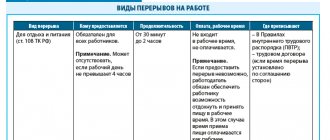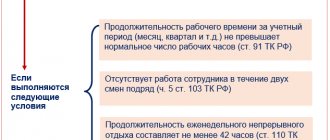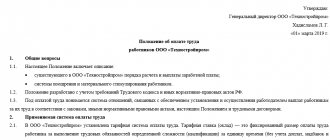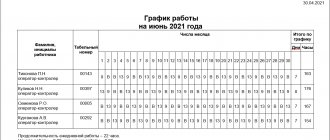Article 91. Concept of working time. Normal working hours
Working time is the time during which an employee, in accordance with internal labor regulations and the terms of the employment contract, must perform labor duties, as well as other periods of time that, in accordance with this Code, other federal laws and other regulatory legal acts of the Russian Federation, relate to working hours.
(as amended by Federal Law No. 90-FZ of June 30, 2006)
Normal working hours cannot exceed 40 hours per week.
The procedure for calculating the norm of working time for certain calendar periods (month, quarter, year), depending on the established duration of working time per week, is determined by the federal executive body exercising the functions of developing state policy and legal regulation in the field of labor.
(Part three introduced by Federal Law dated July 22, 2008 N 157-FZ)
The employer is required to keep records of the time actually worked by each employee.
Average number of working days in a month
If employees are required to work a 40-hour work week, this typically means that they work 5 days a week, 8 hours a day. Accordingly, there are from 21 to 23 working days per month, unless holidays fall on weekdays. For example, in January 2020 there were only 17 days of labor, in February - 19. The most weekdays were in July and December - 23 days each.
Not all citizens have a five-day work week with two days off. In some cases, the employer may increase it by 1 day. Thus, workers work 6 days, not 5. For such citizens, the number of working days per month accordingly increases by 4-5. For example, in July and December, employees working 6 out of 7 days will work 27 days. It is important to say that even with a six-day period, the 40-hour rule must be observed.
In case of production necessity, according to Article 105 of the Labor Code of the Russian Federation, the working day can be divided into parts. However, even in this case, the amount of labor hours cannot exceed the value specified in the contract.
Article 92. Shortened working hours
Shortened working hours are established:
for workers under the age of sixteen - no more than 24 hours a week;
for workers aged sixteen to eighteen years - no more than 35 hours per week;
for employees who are disabled people of group I or II - no more than 35 hours per week;
for workers engaged in work with harmful and (or) dangerous working conditions - no more than 36 hours a week in the manner established by the Government of the Russian Federation, taking into account the opinion of the Russian Tripartite Commission for the Regulation of Social and Labor Relations.
(Part one as amended by Federal Law No. 90-FZ dated June 30, 2006)
The length of working time for students of educational institutions under the age of eighteen, who work during the academic year in their free time from school, cannot exceed half of the norms established by part one of this article for persons of the corresponding age.
(as amended by Federal Law No. 90-FZ of June 30, 2006)
This Code and other federal laws may establish reduced working hours for other categories of workers (teaching, medical and other workers).
(as amended by Federal Law No. 90-FZ of June 30, 2006)
Standard hours for a shift work schedule, summarized recording of working hours
Labor legislation regulates the normal length of the working week - no more than 40 hours in the general case. A shortened week and a shorter duration of daily work are established by the Labor Code of the Russian Federation for certain groups of workers due to their age, health status, training, as well as employment at work with harmful or dangerous working conditions (Articles 92, 94 of the Labor Code of the Russian Federation). These standards are generally applicable, including for shift work.
As for harmful and dangerous working conditions, see the article “Dangerous and harmful production factors (list)” .
However, employers who practice shift work often find it difficult to adhere to the principle of a normal working week of no more than 40 hours. This is due to the specifics of the production process. In this case, Art. 94 of the Labor Code of the Russian Federation allows the employer to use summarized recording of working time.
Receive step-by-step instructions for introducing summarized working time tracking at your enterprise by signing up for a free trial access to the ConsultantPlus system.
When calculating hours worked, the base period is taken to be a month, quarter or year. This period for calculating the number of working hours is called accounting. The time spent by the employee on performing work duties in the accounting period should not exceed the normal number of hours of the working week, a multiple of the number of weeks.
Consequently, when using summarized working time tracking, 1 individual shift may differ in duration both up and down. But in general, the number of hours worked for the period of time accepted as an accounting period should not be more than established for this period, provided that the work hours are normal.
For the form for recording working time and the procedure for filling it out, see the article “Working time sheet - form T-13 (form)” .
The Labor Code of the Russian Federation limits the duration of the accounting period: it cannot be more than 1 year. The use of summarized working time recording affects the fundamental rights of the employee - to work and rest. That is why it must be formalized by a separate local legal act of the employer or a regulation on internal regulations.
Article 93. Part-time work
By agreement between the employee and the employer, a part-time working day (shift) or a part-time working week can be established both upon hiring and subsequently. The employer is obliged to establish a part-time working day (shift) or part-time working week at the request of a pregnant woman, one of the parents (guardian, trustee) with a child under the age of fourteen years (a disabled child under the age of eighteen years), as well as a person carrying out caring for a sick family member in accordance with a medical certificate issued in the manner established by federal laws and other regulatory legal acts of the Russian Federation.
(as amended by Federal Law No. 90-FZ of June 30, 2006)
When working part-time, the employee is paid in proportion to the time he worked or depending on the amount of work he performed.
Part-time work does not entail for employees any restrictions on the duration of annual basic paid leave, calculation of length of service and other labor rights.
Postponement of holidays to 2022
Important!
The annual postponement of holidays is carried out in order to more rationally use working time. It is mandatory to reschedule holidays for employees; the requirement applies to all employers in Russia.
Despite the fact that new holidays are not introduced, and previously adopted holidays are not cancelled, every year the Decree of the Government of the Russian Federation on the transfer of holidays comes into force, for the current year this is Resolution No. 875 of July 10, 2022. In 2022, the next transfer of holidays is carried out :
- instead of January 4 (Saturday), employees will have a rest on May 4 (Monday);
- Instead of January 5 (Sunday), workers will have a day off on May 5 (Tuesday).
As a result, “single” working days (those on the calendar between holidays and weekends) are eliminated from the work schedule, and employees have the opportunity to rest for several days in a row without reporting to the workplace:
- January 1-8,
- February 22-24,
- March 7-9,
- May 1-5,
- May 9-11,
- June 12-14,
- November 4.
Article 94. Duration of daily work (shift)
The duration of daily work (shift) cannot exceed:
for workers aged from fifteen to sixteen years - 5 hours, for workers aged from sixteen to eighteen years - 7 hours;
for students of general education institutions, educational institutions of primary and secondary vocational education, combining study with work during the school year, from fourteen to sixteen years old - 2.5 hours, from sixteen to eighteen years old - 4 hours;
(as amended by Federal Law No. 90-FZ of June 30, 2006)
for disabled people - in accordance with a medical report issued in the manner established by federal laws and other regulatory legal acts of the Russian Federation.
(as amended by Federal Law No. 90-FZ of June 30, 2006)
For workers engaged in work with harmful and (or) dangerous working conditions, where reduced working hours are established, the maximum permissible duration of daily work (shift) cannot exceed:
with a 36-hour work week - 8 hours;
with a 30-hour work week or less - 6 hours.
A collective agreement may provide for an increase in the duration of daily work (shift) compared to the duration of daily work (shift) established by part two of this article for employees engaged in work with harmful and (or) dangerous working conditions, subject to the maximum weekly working hours time (part one of Article 92 of this Code) and hygienic standards for working conditions established by federal laws and other regulatory legal acts of the Russian Federation.
(Part three as amended by Federal Law No. 90-FZ of June 30, 2006)
Duration of daily work (shift) of creative workers of the media, cinematography organizations, television and video crews, theaters, theatrical and concert organizations, circuses and other persons involved in the creation and (or) performance (exhibition) of works, in accordance with the lists jobs, professions, positions of these workers, approved by the Government of the Russian Federation, taking into account the opinion of the Russian Tripartite Commission for the Regulation of Social and Labor Relations, can be established by a collective agreement, a local regulatory act, or an employment contract.
(Part four was introduced by Federal Law No. 90-FZ of June 30, 2006, as amended by Federal Law No. 13-FZ of February 28, 2008)
Annual standard working hours (calculation)
There are 2 options for calculating the annual working hours for company employees:
- You can add up the previously calculated monthly norms.
- It is allowed to calculate the annual rate in the same way as the monthly one (then it is necessary to reduce the annual rate by 1 hour for each pre-holiday day, shortened due to the upcoming holiday - the list of such days was given above)
.
If the company has a standard working week (5 days) with two days off, in 2022 the annual working time will be calculated as follows:
| № | How many hours in a week? | Calculation of the annual rate | Annual Hours |
| 1 | 40 hours | 248 working days x 40 hours: 5 working days. days | 1 979 |
| 2 | 36 hours | 248 working days x 36 hours: 5 working days days | 1 780,6 |
| 3 | 24 hours | 248 working days x 24 hours: 5 working days days | 1 185,4 |
Article 95. Duration of work on the eve of non-working holidays and weekends
The length of the working day or shift immediately preceding a non-working holiday is reduced by one hour.
In continuously operating organizations and in certain types of work, where it is impossible to reduce the duration of work (shift) on a pre-holiday day, overtime is compensated by providing the employee with additional rest time or, with the employee’s consent, payment according to the standards established for overtime work.
On the eve of the weekend, the duration of work in a six-day work week cannot exceed five hours.
Rules for determining non-working days
According to Article 112 of the Labor Code of the Russian Federation, holidays in the Russian Federation are:
- January 1, 2, 3, 4, 5, 6 and 8 - New Year,
- January 7 - Nativity of Christ,
- February 23 - Defender of the Fatherland Day,
- March 8 - International Women's Day,
- May 1 - Spring and Labor Festival,
- May 9 - Victory Day,
- June 12 - Russia Day,
- November 4 — National Unity Day
If a holiday falls on a Saturday or Sunday, it is transferred, and not necessarily to the next working day. Thus, non-working days that fall on the first Saturday or Sunday of January can be moved to May. Sometimes a day of rest, Saturday or Sunday, can be made a working day in order for the subsequent segment of holidays to be longer and more continuous. An unambiguous decision on exactly what transfers will be and what non-working days will be next year is formulated by the Russian government in its own separate resolution. As a rule, such a resolution is issued in the fall and regulates only the situation in the next year. Until this order is issued, we can only make assumptions for future years. Obviously, it is not possible to accurately calculate what date will occur, say, 1,000 business days from today's date. Therefore, if your calculations include such periods from the future, you need to be prepared that today we can only talk about approximate estimates.
Article 96. Night work
Night time is the time from 22:00 to 6:00.
The duration of work (shift) at night is reduced by one hour without further work.
(as amended by Federal Law No. 90-FZ of June 30, 2006)
The duration of work (shift) at night is not reduced for employees who have a reduced working time, as well as for employees hired specifically to work at night, unless otherwise provided by the collective agreement.
The duration of work at night is equal to the duration of work during the day in cases where this is necessary due to working conditions, as well as for shift work with a six-day work week with one day off. The list of specified works may be determined by a collective agreement or local regulations.
The following are not allowed to work at night: pregnant women; workers under the age of eighteen, with the exception of persons involved in the creation and (or) performance of artistic works, and other categories of workers in accordance with this Code and other federal laws. Women with children under three years of age, disabled people, workers with disabled children, as well as workers caring for sick members of their families in accordance with a medical certificate issued in the manner established by federal laws and other regulatory legal acts of the Russian Federation , mothers and fathers raising children under the age of five without a spouse, as well as guardians of children of the specified age, may be involved in night work only with their written consent and provided that such work is not prohibited to them for health reasons in accordance with the medical report. At the same time, these employees must be informed in writing of their right to refuse to work at night.
(as amended by Federal Laws dated July 24, 2002 N 97-FZ, dated June 30, 2006 N 90-FZ)
Procedure for night work of creative workers of the media, cinematography organizations, television and video film crews, theaters, theatrical and concert organizations, circuses and other persons involved in the creation and (or) performance (exhibition) of works, in accordance with the lists of works , professions, positions of these workers, approved by the Government of the Russian Federation, taking into account the opinion of the Russian Tripartite Commission for the Regulation of Social and Labor Relations, can be established by a collective agreement, a local regulatory act, or an employment contract.
(as amended by Federal Laws dated June 30, 2006 N 90-FZ, dated February 28, 2008 N 13-FZ)
Article 97. Work outside the established working hours
(as amended by Federal Law No. 90-FZ of June 30, 2006)
The employer has the right, in the manner established by this Code, to involve an employee in work beyond the working hours established for this employee in accordance with this Code, other federal laws and other regulatory legal acts of the Russian Federation, collective agreements, agreements, local regulations, employment contract (hereinafter referred to as the working hours established for the employee):
for overtime work (Article 99 of this Code);
if the employee works on irregular working hours (Article 101 of this Code).
Table: Working hours standards for 2022
By number of working days
| Month / Quarter / Year | Amount of days | ||
| Calendar | workers | Weekends | |
| January | 31 | 16 | 15 |
| February | 28 | 19 | 9 |
| March | 31 | 22 | 9 |
| April | 30 | 21 | 9 |
| May | 31 | 18 | 13 |
| June | 30 | 21 | 9 |
| July | 31 | 21 | 10 |
| August | 31 | 23 | 8 |
| September | 30 | 22 | 8 |
| October | 31 | 21 | 10 |
| November | 30 | 21 | 9 |
| December | 31 | 22 | 9 |
| 1st quarter | 90 | 57 | 33 |
| 2nd quarter | 91 | 61 | 31 |
| 3rd quarter | 92 | 66 | 26 |
| 4th quarter | 92 | 64 | 28 |
| 2022 | 365 | 247 | 118 |
By number of working hours
| MONTH / QUARTER / YEAR | WORKING TIME (HOUR) | ||
| 40 HOURS/WEEK | 36 HOUR/WEEK | 24 HOURS/WEEK | |
| January | 128 | 115,2 | 76,8 |
| February | 151 | 135,8 | 90,2 |
| March | 175 | 157,4 | 104,6 |
| April | 168 | 151,2 | 100,8 |
| May | 144 | 129,6 | 86,4 |
| June | 168 | 151,2 | 100,8 |
| July | 168 | 151,2 | 100,8 |
| August | 184 | 165,6 | 100,4 |
| September | 176 | 158,4 | 105,6 |
| October | 168 | 151,2 | 100,8 |
| November | 167 | 150,2 | 99,8 |
| December | 176 | 158,4 | 105,6 |
| 1st quarter | 454 | 408.4 | 271.6 |
| 2nd quarter | 480 | 432 | 288 |
| 3rd quarter | 528 | 475.2 | 316.8 |
| 4th quarter | 511 | 459,8 | 306,2 |
| 2022 YEAR | 1973 | 1775.4 | 1182.6 |
The article was edited in accordance with current legislation 01/05/2022








